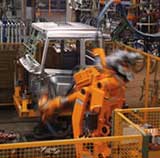Stiff challenge to instability

The secret of a steady hand is tightening the right muscles.
Controlling the stiffness of some of our muscles lets us manage tricky feats of manipulation, such as keeping a screwdriver in a screw, researchers have found1. We tune the stiffness to oppose motions in the direction of instability, such as the sideways slips that would let the screwdriver slide out of the slot.
Although demanding on the brain, this is the most energy-efficient strategy, say Mitsuo Kawato of ATR Human Information Science Laboratories in Kyoto, Japan, and co-workers. Tightening all the muscles involved in a task reduces errors, but uses more energy. So the central nervous system learns from experience to contract only the muscles controlling motions in the direction of the most detrimental errors.
The strategy could be emulated to design more energy-efficient industrial robots – although their computer-control systems would need to be capable of learning.
Another way of coping with the instabilities of fiddly tasks – the one currently used by robot engineers – is feedback control. Here, if motion begins to occur in an unwanted direction, the limb activates muscles that bring the object back to the desired position. This is basically how, for example, a tightrope walker avoids falling.
But feedback control is too slow for very small, rapid movements. The brain can’t register and compensate fast enough, so this approach can actually contribute to instabilities rather than counteracting them.
Control centre
To show that the central nervous system uses stiffness changes – called impedance control – to regulate unstable manipulations, Kawato’s team asked seated volunteers to make straight, horizontal arm movements from some starting position to a target position in front of them. If their movement strayed from a straight line, a robotic system attached to their forearm pushed them even further off course, forcing them to compensate.
Initially, the robot pushed subjects way off course. But after 100 or so trials, they learnt to counteract it, and most hit the target. By measuring the small deviations and the stabilizing forces the subjects’ arms exerted on the robotic system, the researchers estimated changes in muscle stiffness.
They found that the training runs taught subjects to tighten the muscles that control side-to-side movements more than those governing forward movements. In other words, the stiffening was tailored to resist the deflections that the robotic system produced. Muscles controlling backwards and forwards motions, which did not take the arm away from the intended path, stayed more loose.
- Burdet, E., Osu, R., Franklin, D. W., Milner, T. E. & Kawato, M. The central nervous system stabilizes unstable dynamics by learning optimal impedance. Nature, 414, 446 – 449, (2001).
Media Contact
All latest news from the category: Interdisciplinary Research
News and developments from the field of interdisciplinary research.
Among other topics, you can find stimulating reports and articles related to microsystems, emotions research, futures research and stratospheric research.
Newest articles

Sea slugs inspire highly stretchable biomedical sensor
USC Viterbi School of Engineering researcher Hangbo Zhao presents findings on highly stretchable and customizable microneedles for application in fields including neuroscience, tissue engineering, and wearable bioelectronics. The revolution in…

Twisting and binding matter waves with photons in a cavity
Precisely measuring the energy states of individual atoms has been a historical challenge for physicists due to atomic recoil. When an atom interacts with a photon, the atom “recoils” in…

Nanotubes, nanoparticles, and antibodies detect tiny amounts of fentanyl
New sensor is six orders of magnitude more sensitive than the next best thing. A research team at Pitt led by Alexander Star, a chemistry professor in the Kenneth P. Dietrich…





















